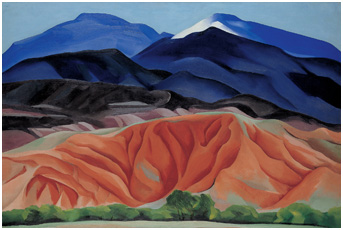Natural and Unnatural Affinities in Twentieth Century Art and Photography
by Peter F. Guerrero
Looking In: Robert Frank’s “The Americans,” Through August 23, 2009.
Georgia O’Keefe and Ansel Adams: Natural Affinities, Through September 7, 2009.
The San Francisco Museum of Modern Art
151 Third Street, San Francisco
www.sfmoma.org
Natural Affinities, an exhibition currently at the San Francisco Museum of Modern Art (SFMOMA), compares the art of Georgia O’Keefe with the photography of Ansel Adams, bringing together nearly 100 works by both artists to demonstrate a shared vision of the natural world despite their having worked in very different media: O’Keefe is best known for her abstract watercolors and oils of the Southwest and her sensuous macro images of flowers; Adams is best known for his iconic photos of the West taken with a large format camera and printed with exquisite detail and high contrast. Indeed, both artists shared a love of the Western landscape, but their shared affinities go deeper.
Both were protégées of Alfred Stieglitz who sought to create a uniquely American aesthetic unbounded by European traditions. Stieglitz recognized in photography the quintessential modern medium that would transform the very nature of art. Photography allowed the extreme enlargement of detail, well-framed and cropped edges, ordinary objects to be examined from a variety of vantage points, and a compressed sense of space that evokes, but is quite different from, the three-dimensional world we inhabit. So it is not surprising that O’Keefe’s long association with Stieglitz and her familiarity with the work of Adams would impart a photographic sensibility to her work. And it is precisely her attention to detail and vantage point that makes her work both distinctive and memorable.

© Georgia O'Keeffe Museum
In contrast, Adams’ oeuvre is influenced more by the aesthetic of the 19th century romantic painters—Albert Bierstadt, Frederic Edwin Church, and other artists associated with the Hudson River School—than it is by his casual association with O’Keefe. These 19th century landscape images are infused with a theatrical sense of lighting and the drama of untamed nature. Even well into the 20th century, Adams was still under their influence as seen in his 1960 photograph of a menacing thunderstorm near Cimarron, New Mexico. Looking at an Adams’ photograph, we can’t help but feel wonder and amazement at our place in the universe, small and fragile, like the cemetery markers backlight by the setting sun as the moon rises over the Sangre de Cristo mountains and the tiny hamlet of Hernandez, New Mexico.

© 2009 The Ansel Adams Publishing Rights Trust
But a visit to another current SFMOMA exhibition makes for a more challenging comparison. This one celebrates the fiftieth anniversary of the publication of Robert Frank’s The Americans, a candid and stark photographic essay of post-war America prescient in its documentation of what the children of the Greatest Generation would come to reject in the turmoil of the 1960s. Unlike Adams, Frank was influenced by the Depression-era documentary photographs of Walker Evens and Dorothea Lange. Working with a small, 35mm Leica camera, Frank composed on the run using high-speed film to capture the essence of the moment. With the support of a Guggenheim Fellowship, Frank set off in the mid-1950’s in a used Ford and without a set itinerary. He ultimately shot 767 rolls of film and over 27,000 images, returning to his studio to print over 1,000 rough 8x10 prints that would be the source for the 83 images that ultimately found their way into the book. These photographs were then juxtaposed, often placing images of indifferent wealth and excess next to the scenes of poverty and despair. Frank shows us the world of sleazy bars and casinos, dilapidated rooming houses, lonely farmhouses and anonymous city streets. This is America in the throes of the cold war, menaced by the threat of the atomic bomb, somber and filled with contradictions. Indeed, Frank intended that his book stand in stark contrast to Life magazine’s view of the 1950’s as a narrative with a predictable beginning, middle and end.

Frank’s photographs are in sharp contrast with Adams’. They are small and grainy, seemingly of newsroom archival quality. Adams’ work, on the other hand, is crisp, clear, and luminous. And, just as we might shy away from the stark social reality of Frank’s images we are drawn to the detail and beauty of the natural world in Adams’ work. Delightfully, both show us the power of photography to shape aesthetic sensibilities and our view of the world.
Peter F. Guerrero, a photographer and writer in Berkeley, California. He can be reached at: Studio374@me.com
